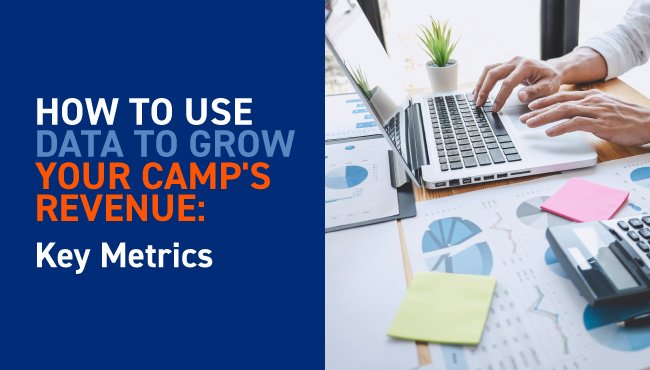How to Use Data to Grow Your Camp's Revenue: Key Metrics
As a camp leader, you’re likely always looking for ways to make your operations more efficient and increase revenue. Developing a solid understanding of your cash flow, creating a detailed budget, finding ways to reduce costs, and diversifying your revenue stream will help you prepare for economic slumps. However, tracking and reporting this data manually can be time- and labor-intensive. Luckily, technology has the power to help you raise more through data and analytics.
Tracking key camp metrics and generating customized reports can help you visualize your camp’s finances and performance to identify solutions to obstacles and opportunities to increase revenue. In this guide, we’ll walk through how you can use summer camp management software to monitor key camp metrics and leverage customized reports to benefit your camp. Let’s get started!
Key Types of Data to Track at Your Summer Camp
Gathering data related to your camp’s performance and finances is the most effective way to track progress, meet your goals, and make wise business decisions. A few key types of camp data that you should collect and track include:
Camper data. Track trends in campers’ demographic characteristics like gender, ethnicity, and age and add this information to personalized camper profiles. Gather registration and attendance data for specific activities to measure camper retention, the popularity of individual programs, and your camp’s overall performance.
Staff and hiring data. Collect specific data like how many staff members were hired each season, volunteer retention rates, and the number of staff members scheduled for certain activities. During future seasons, you can use this information to inform hiring decisions and improve scheduling to ensure all responsibilities are covered.
Supplies inventory. Your camp management software can help you monitor inventory across different locations (e.g., your storage facility, camp gift shop, and dining hall) while housing all of the data in one platform. In addition to tracking food and medical supplies, the right solution will pair with your point-of-sale (POS) system to maintain up-to-date records of your merchandise inventory.
Expenses. With necessary expenses such as rent, insurance, food, rentals, and more, it can be difficult to figure out what your total monthly or yearly costs are. Camp management software can assist with tracking each expense so you’ll have an accurate understanding of your profits and stay on top of payments.
Donations. If your camp is a nonprofit organization, collecting and tracking the donations you receive from supporters is essential for staying funded, maintaining financial transparency, and ensuring accurate accounting. Plus, keeping your fundraising records up-to-date and accurate will help you relay your funding details to stakeholders and make your life easier during tax season.
Events. Alumni events (celebrations inviting former campers to revisit your camp and introduce their children to your program) or community events like races can attract new campers and help you expand your reach. These events can be expensive, so it’s crucial to measure how many people attend and how many are converted to customers to accurately measure the events’ ROI.
Camper satisfaction. According to CIRCUITREE, you can improve camper retention and increase re-enrollments by tracking how satisfied a camper is with your camp’s offerings. A robust camp management tool will allow you to create satisfaction surveys and send them out to previous campers. Then, when campers answer the surveys, your solution will collect the feedback and highlight key insights for you.
These metrics are excellent starting points for your camp when it comes to understanding cash flow, accurately tracking revenue sources, and measuring the success of new ventures. With this information, you’ll be empowered to make revenue-growing decisions with confidence.
Leverage Reports to Make Data-Driven Decisions
After gathering key data points for your camp, you can compile your findings into detailed reports that will guide you in making data-backed decisions for your camp. When deciding on software for your camp, select a solution that offers useful templates along with customizable reports to help you visualize patterns in your data, streamline operations, limit waste, and capitalize on revenue opportunities.
Use your software’s reporting capabilities to your advantage by:
Creating custom dashboards. Build a dashboard that reflects the most relevant data for your camp, such as enrollment rates and revenue from merchandise sales, so you can get a sense of its performance and financial situation with just a glance. Adjust these dashboards according to the time of year or any specific goals you’re pursuing. For instance, during the winter months, you might monitor your e-commerce sales more closely. In the spring, you might change your focus to registrations as they begin to pick back up.
Generating accounting reports frequently. Quickly generate accounting reports like income statements, cash flow statements, and balance sheets based on the data you collect. Not only do these reports provide a snapshot of your financial status, but generating them regularly allows you to create a detailed record of your financial history. These reports are essential for tracking transactions, sticking to your budget, and getting a general sense of how well your business is doing.
Forecasting the camp’s financial future. Having several months’ or years’ worth of reports will help you make more accurate predictions about future revenue, expenses, and camp performance. For instance, by reviewing past cash flow statements, you can estimate how much revenue your business will generate in the coming year to budget and plan accordingly. This puts you on the path to achieving your financial goals and avoiding unnecessary costs.
Additionally, camp software will help you manage your data and keep it accurate and up-to-date. According to Accudata, this concept is called data hygiene—essentially, “dirty” data contains errors that make your job and your staff members’ jobs more difficult. This could mean that the date is incomplete, duplicated, outdated, or outright incorrect. With “clean” data, you can be confident that the reports you generate accurately reflect the state of your camp.
Effectively demonstrating your camp’s performance and impact is a critical component of camp management, particularly when you need to justify financial decisions for stakeholders or advocate for more funding. With camp management software, you’ll be able to accurately track data year-round and store it in easy-to-reference, intuitive reports to make showing your camp’s value easy. As you research potential solutions for your camp, consider the key metrics you’ll want to track and whether they will help you do that.
Guest Author: Glen Greenstone
Before becoming a camp professional, Glen enjoyed many other pursuits. A native San Diegan, he worked through college as a 9-1-1 dispatcher. He has a passion for literature and the outdoors, and is a veteran of U.S. Coast Guard, so he naturally loves to get out on the water with his wife and two kids whenever possible. He loves hearing camp cheers outside his office window during the summer, while helping camps across the country overcome their unique challenges!


